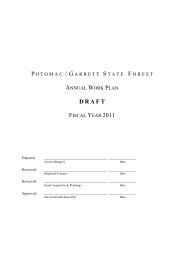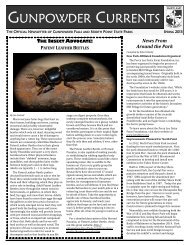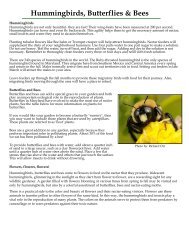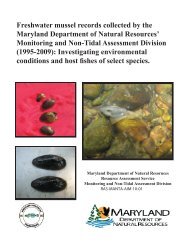tidal hardwood swamps - Maryland Department of Natural Resources
tidal hardwood swamps - Maryland Department of Natural Resources
tidal hardwood swamps - Maryland Department of Natural Resources
Create successful ePaper yourself
Turn your PDF publications into a flip-book with our unique Google optimized e-Paper software.
STATE RANK<br />
S1 Highly State rare. Critically imperiled in <strong>Maryland</strong> because <strong>of</strong> extreme rarity (typically 5 or fewer<br />
estimated occurrences or very few remaining individuals or acres in the State) or because <strong>of</strong><br />
some factor(s) making it especially vulnerable to extirpation. Species with this rank are actively<br />
tracked by the <strong>Natural</strong> Heritage Program.<br />
S2 State rare. Imperiled in <strong>Maryland</strong> because <strong>of</strong> rarity (typically 6 to 20 estimated occurrences or<br />
few remaining individuals or acres in the State) or because <strong>of</strong> some factor(s) making it<br />
vulnerable to becoming extirpated. Species with this rank are actively tracked by the <strong>Natural</strong><br />
Heritage Program.<br />
S3 Watch List. Rare to uncommon with the number <strong>of</strong> occurrences typically in the range <strong>of</strong> 21 to<br />
100 in <strong>Maryland</strong>. It may have fewer occurrences but with a large number <strong>of</strong> individuals in some<br />
populations, and it may be susceptible to large-scale disturbances. Species with this rank are<br />
not actively tracked by the <strong>Natural</strong> Heritage Program.<br />
S3.1 A "Watch List" species that is actively tracked by the <strong>Natural</strong> Heritage Program because <strong>of</strong> the<br />
global significance <strong>of</strong> <strong>Maryland</strong> occurrences. For instance, a G3 S3 species is globally rare to<br />
uncommon, and although it may not be currently threatened with extirpation in <strong>Maryland</strong>, its<br />
occurrences in <strong>Maryland</strong> may be critical to the long term security <strong>of</strong> the species. Therefore, its<br />
status in the State is being monitored.<br />
S4 Apparently secure in <strong>Maryland</strong> with typically more than 100 occurrences in the State or may<br />
have fewer occurrences if they contain large numbers <strong>of</strong> individuals. It is apparently secure<br />
under present conditions, although it may be restricted to only a portion <strong>of</strong> the State.<br />
S5 Demonstrably secure in <strong>Maryland</strong> under present conditions.<br />
SA Accidental or a vagrant in <strong>Maryland</strong>.<br />
SE Established, but not native to <strong>Maryland</strong>; it may be native elsewhere in North America.<br />
SH Historically known from <strong>Maryland</strong>, but not verified for an extended period (usually 20 or more<br />
years), with the expectation that it may be rediscovered.<br />
SP Potentially occurring in <strong>Maryland</strong> or likely to have occurred in <strong>Maryland</strong> (but without persuasive<br />
documentation).<br />
SR Reported from <strong>Maryland</strong>, but without persuasive documentation that would provide a basis for<br />
either accepting or rejecting the report (e.g., no voucher specimen exists).<br />
SRF Reported falsely (in error) from <strong>Maryland</strong>, and the error may persist in the literature.<br />
SU Possibly rare in <strong>Maryland</strong>, but <strong>of</strong> uncertain status for reasons including lack <strong>of</strong> historical records,<br />
low search effort, cryptic nature <strong>of</strong> the species, or concerns that the species may not be native to<br />
the State. Uncertainty spans a range <strong>of</strong> 4 or 5 ranks as defined above.<br />
SX Believed to be extirpated in <strong>Maryland</strong> with virtually no chance <strong>of</strong> rediscovery.<br />
S? The species has not yet been ranked.<br />
_B This species is a migrant and the rank refers only to the breeding status <strong>of</strong> the species. Such a<br />
migrant may have a different rarity rank for non-breeding populations.<br />
90
















